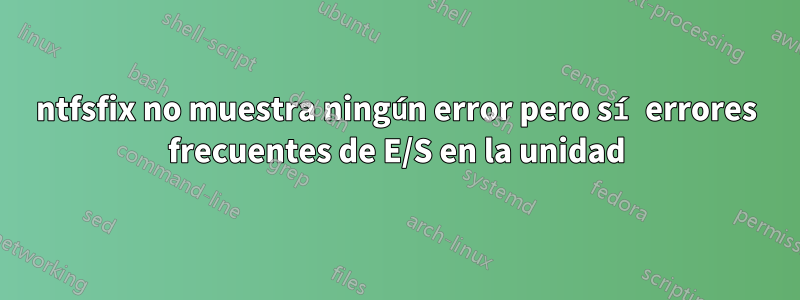
Tengo un disco NTFS montado como unidad de datos en un sistema Ubuntu (19.10).
En los últimos días, el disco se ha vuelto muy lento y poco confiable.
El diario (journalctl -r) muestra esto:
Nov 20 15:23:39 acer smartd[1253]: Device: /dev/sdb [SAT], SMART Usage Attribute: 194 Temperature_Celsius changed from 54 to 53
Nov 20 15:23:39 acer smartd[1253]: Device: /dev/sdb [SAT], SMART Usage Attribute: 190 Airflow_Temperature_Cel changed from 46 to 47
Nov 20 15:23:39 acer smartd[1253]: Device: /dev/sdb [SAT], SMART Usage Attribute: 188 Command_Timeout changed from 100 to 99
Nov 20 15:23:39 acer smartd[1253]: Device: /dev/sdb [SAT], SMART Usage Attribute: 183 Runtime_Bad_Block changed from 97 to 96
Nov 20 15:23:39 acer smartd[1253]: Device: /dev/sdb [SAT], 41344 Offline uncorrectable sectors (changed +8)
...
Nov 20 15:23:39 acer smartd[1253]: Device: /dev/sdb [SAT], 41344 Currently unreadable (pending) sectors (changed +8)
Sin embargo, ntfsfixinforma que el disco está bien (creo)
sudo ntfsfix -bd /dev/sdb1
Mounting volume... OK
Processing of $MFT and $MFTMirr completed successfully.
Checking the alternate boot sector... OK
NTFS volume version is 3.1.
Going to un-mark the bad clusters ($BadClus)... No bad clusters...OK
NTFS partition /dev/sdb1 was processed successfully.
- ¿Existe otra forma de comprobar este disco?
A sugerencias de comentarios algunos smartctlresultados.
smartctl -data -A /dev/sdb
smartctl 7.0 2018-12-30 r4883 [x86_64-linux-5.3.0-23-generic] (local build)
Copyright (C) 2002-18, Bruce Allen, Christian Franke, www.smartmontools.org
[=== START OF READ SMART DATA SECTION ===
SMART Attributes Data Structure revision number: 10
Vendor Specific SMART Attributes with Thresholds:
ID# ATTRIBUTE_NAME FLAG VALUE WORST THRESH TYPE UPDATED WHEN_FAILED RAW_VALUE
1 Raw_Read_Error_Rate 0x000f 079 078 006 Pre-fail Always - 168133076
3 Spin_Up_Time 0x0003 094 092 000 Pre-fail Always - 0
4 Start_Stop_Count 0x0032 099 099 020 Old_age Always - 1209
5 Reallocated_Sector_Ct 0x0033 093 093 036 Pre-fail Always - 9840
7 Seek_Error_Rate 0x000f 074 060 030 Pre-fail Always - 8648101443
9 Power_On_Hours 0x0032 073 073 000 Old_age Always - 24172
10 Spin_Retry_Count 0x0013 100 100 097 Pre-fail Always - 0
12 Power_Cycle_Count 0x0032 099 099 020 Old_age Always - 1237
183 Runtime_Bad_Block 0x0032 096 096 000 Old_age Always - 4
184 End-to-End_Error 0x0032 100 100 099 Old_age Always - 0
187 Reported_Uncorrect 0x0032 001 001 000 Old_age Always - 12019
188 Command_Timeout 0x0032 099 098 000 Old_age Always - 11 26 26
189 High_Fly_Writes 0x003a 097 097 000 Old_age Always - 3
190 Airflow_Temperature_Cel 0x0022 047 042 045 Old_age Always In_the_past 53 (Min/Max 47/58 #91)
191 G-Sense_Error_Rate 0x0032 100 100 000 Old_age Always - 0
192 Power-Off_Retract_Count 0x0032 100 100 000 Old_age Always - 1217
193 Load_Cycle_Count 0x0032 099 099 000 Old_age Always - 3392
194 Temperature_Celsius 0x0022 053 058 000 Old_age Always - 53 (0 18 0 0 0)
197 Current_Pending_Sector 0x0012 001 001 000 Old_age Always - 41344
198 Offline_Uncorrectable 0x0010 001 001 000 Old_age Offline - 41344
199 UDMA_CRC_Error_Count 0x003e 200 200 000 Old_age Always - 0
240 Head_Flying_Hours 0x0000 100 253 000 Old_age Offline - 23784h+22m+27.579s
241 Total_LBAs_Written 0x0000 100 253 000 Old_age Offline - 16322055947757
242 Total_LBAs_Read 0x0000 100 253 000 Old_age Offline - 108452827544617
No sé cómo interpretarlo exactamente pero parece algún problema de calefacción.
Respuesta1
Se recomienda reemplazar la unidad.
Smart 05 significa cuántos sectores de repuesto se utilizan para reemplazar los sectores defectuosos. El valor RAW 9840 significa 9840 sectores, lo que significa 4920 KB. 93 es un valor normalizado, lo que significa que todavía tiene un 93 % de sectores de repuesto.
Sin embargo, al mismo tiempo, 197 indica que hay 41344 sectores pendientes. Los sectores pendientes no significa necesariamente que esos sectores estén defectuosos, pero el disco duro no pudo procesarlos por completo. (A veces porque no se lavó antes de la interrupción del suministro eléctrico). En la siguiente escritura, volverá a un buen estado del sector o irá a 05 y será reemplazado por sectores de repuesto.
De cualquier manera, 41344 ya tiene alrededor de 20 MB. Lo cual ya es demasiado y significa que su disco no es estable.
Respuesta2
Dado que tiene una copia de seguridad de los datos en la nube, podemos preparar el disco para un bloqueo defectuoso, de esta manera...
utilícelo
gpartedpara establecer una nueva tabla de particiones GPT (ESTO LIMPIARA LA UNIDAD)utilizar
gpartedpara crear una única partición ext4 que utilice todo el espacio no asignado(siempre puedes recrear una partición NTFS después de bloquear mal el disco)
Note: do NOT abort a bad block scan!
Note: do NOT bad block a SSD
Note: backup your important files FIRST!
Note: this will take many hours
Note: you may have a pending HDD failure
Arranque desde un DVD/USB de Ubuntu Live.
En terminal...
sudo fdisk -l# identificar todas las particiones del "sistema de archivos Linux"
Nota: asegúrese de identificar correctamente qué unidad está bloqueada de forma incorrecta... sdb1/etc.
sudo e2fsck -fcky /dev/sdXX# prueba de solo lectura
o
sudo e2fsck -fccky /dev/sdXX# prueba de lectura/escritura no destructiva(recomendado)
El -k es importante porque guarda la tabla de bloques defectuosos anterior y agrega cualquier bloque defectuoso nuevo a esa tabla. Sin -k, se pierde toda la información del bloque defectuoso anterior.
El parámetro -fccky...
-f Force checking even if the file system seems clean.
-c This option causes e2fsck to use badblocks(8) program to do a
read-only scan of the device in order to find any bad blocks.
If any bad blocks are found, they are added to the bad block
inode to prevent them from being allocated to a file or direc‐
tory. If this option is specified twice, then the bad block
scan will be done using a non-destructive read-write test.
-k When combined with the -c option, any existing bad blocks in the
bad blocks list are preserved, and any new bad blocks found by
running badblocks(8) will be added to the existing bad blocks
list.
-y Assume an answer of `yes' to all questions; allows e2fsck to be
used non-interactively. This option may not be specified at the
same time as the -n or -p options.
Nota: si un bloqueo incorrecto no da como resultado una unidad utilizable, reemplácela.


